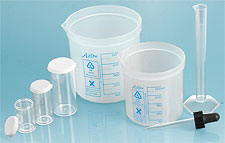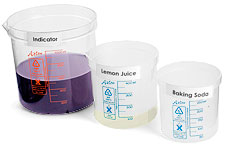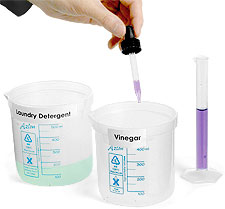Lab Supplies Needed
Other Items Needed
- Red Cabbage
- Large Pot
- Assorted Solutions
- Water
View More Science Fair Project Ideas
Chemistry Lab - pH Balance
Recommended Grade Level: Middle School
the Video!
 Download PDF Lab Sheet
Download PDF Lab Sheet
For a creative approach to exploring pH levels in everyday items, create your own pH indicator using red cabbage. This is a simple, safe approach to chemistry that can help your students understand the difference in pH balance of items in their everyday lives.
Everyday items become the test solutions for the lab. Try asking your students to hypothesize which solutions they believe to be acidic and which they believe are basic. Compare your hypotheses to your conclusions at the end of this lab.
While this lab is very safe, it is important to always monitor your student during any laboratory activity. Be sure to use lab safety precautions during this and all labs. If you choose to use more toxic chemicals, such as household cleaners, we recommend you wear safety gloves and goggles to prevent injury

1. Making the Indicator
Start by carefully grating about a half a head of red cabbage into small pieces. Add these pieces to a pot of water, and bring to a boil, allowing to boil for about 20 minutes. Once the liquid has turned a dark purple-red color, you are ready to strain the liquid into a jar or other reclosable container. Set aside the cabbage, and observe that the water should be a dark purple-blue color.

2. Setting up your Materials
Now, put together several solutions to test with your new pH indicator. These could be many household items, such as vinegar, lemon juice, laundry detergent and baking soda, as well as many other clear liquid you might find around the home. Be sure to have a control for this experiment by keeping a beaker of a neutral liquid (distilled water) on hand. You will have to add water to the baking soda to test the pH, and it is best to dilute the other liquids used in this experiment so they are mostly translucent, making the pH easier to detect.

3. Testing your Solutions
Add a few drops of your cabbage pH indicator to each of your test solutions and record any color change that occurs. Acidic solutions should turn pink in the presence of the cabbage indicator, while basic solutions should turn a greenish color.
4. Calculations & Conclusions
Discuss your results. Which tested solutions were most acidic? Which were most basic? How do these finding effect your perceptions of common household items? For more test solution ideas, try investigating new ideas found by searching the web for acidic and basic solutions.
 Plastic Beakers
Plastic Beakers Graduated Cylinder
Graduated Cylinder Eyedropper
Eyedropper Reclosable Jar
Reclosable Jar